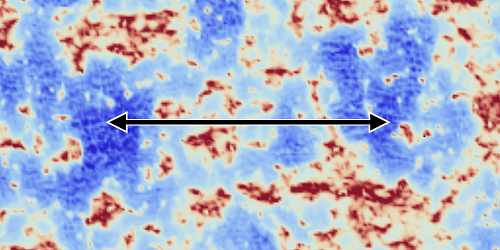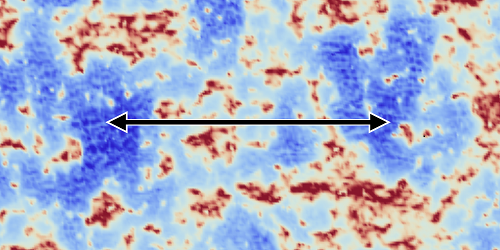A Cosmic Ruler at 21 Centimeters
Astronomers use standard rulers—objects or features of known length—to determine the cosmic expansion rate, also known as the Hubble parameter. A potential new standard ruler, proposed by Julian Muñoz of Harvard University, is based on rippling patterns in the early Universe called velocity-induced acoustic oscillations (VAOs). In a pair of papers, Muñoz demonstrates that the effect of VAOs could be identified in upcoming observations of the first stars made at radio wavelengths of around 21 cm. This VAO ruler could help resolve ongoing disagreements between measurements of the Hubble parameter.
VAOs formed in the hot early Universe, when ordinary matter was pushed around by radiation pressure but dark matter wasn’t. This difference led to a mismatch in the velocity of ordinary vs dark matter, and this mismatch varied spatially in a 3D oscillation pattern. However, VAOs have never been directly observed, and it was generally thought that they would be masked by other mechanisms that affect the velocity of ordinary matter, such as gas hydrodynamics.
Muñoz has shown that a VAO signal may be recoverable from observations of hydrogen absorption at 21 cm. Several surveys plan to map the 21-cm absorption across the sky, which should reveal the spatial distribution of the first stars that formed around 200 million years after the big bang. As Muñoz describes in Physical Review D, computer simulations of 21-cm maps incorporating the effect of VAOs show that a region with a large velocity mismatch will suppress early star formation and, in turn, become a strong absorption spot in the 21-cm sky.
Writing in Physical Review Letters, Muñoz shows that the spacing of strong (as well as weak) absorption spots has a characteristic length scale of 450 million light years. In the next few years, radio telescopes, such as the planned Hydrogen Epoch of Reionization Array, could potentially observe the regularly spaced spots and use them as a ruler with which to estimate the Universe’s expansion rate at a point in time that has so far been unexplored.
This research is published in Physical Review D and Physical Review Letters.
–Michael Schirber
Michael Schirber is a Corresponding Editor for Physics based in Lyon, France.





